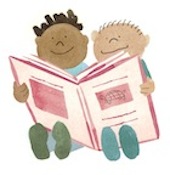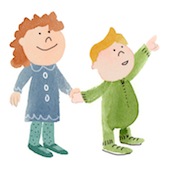lab for early social cognition
at the University of Maryland, College Park
links to child studies consortium or psychology department @ UMD
Research Topics
Our research investigates the origins and development of social cognition and behavior, primarily through studies with infants, toddlers, and young children. We employ a variety of behavioral methods in this pursuit, from looking time and eye-tracking methodologies to measures of children’s active helping and communicative behaviors.
We offer here an overview of some of the questions that motivate our research. You can learn more about our Study Methods and Recent Findings on separate pages.
The development of mindreading

A powerful way to understand and predict another person’s behavior is to consider what she is thinking. What does she see; what does she believe; what does she want? However, this is a much more challenging task than it might appear to be! Because we cannot hear another person’s thoughts, or feel her goals, we must instead make inferences about these unseen mental events, based on our own sophisticated understanding of how people typically think and feel.
As researchers studying cognitive development, we ask how young children become able to reason about other people’s minds. On what cognitive mechanisms is this ability based, and how do they develop? How much of this understanding is innately “built in” to the human mind, and how do children’s own experiences and observations add to their understanding? By studying development, we can also learn more about what makes people better at mindreading than other animals.
Much of our lab’s research on these issues currently falls into two related areas. Some of our studies investigate how very young children determine whether a novel entity, something they’ve never seen before, is more like an animate agent (with a mind) or an inanimate object (without one). Other studies ask how children relate specific physical behaviors to the underlying mental experiences of the people who perform those behaviors. We have paid particular attention to how children understand eye gaze and its many important functions. How do infants know that a person pointing her eyes in a particular direction can see some things and not others? How do they come to recognize the predictive power of a person’s looks – that she will likely look at something before acting on it? What do they understand about the special social function of eye contact between two people?
Understanding social relationships

People rarely live entirely alone. We cultivate friendships, find ourselves vying for status among peers, and feel close to those like us and distant from dissimilar others. We identify as members of families, teams, social categories such as gender and race, and cultures. All of these invisible bonds with other people bring incredible meaning to our lives.
Thinking about social connections is also an enormously useful tool when we try to make sense of other people’s behavior. Just like the ability to reflect on a person’s goals and beliefs, recognizing how different relationships influence a person’s behavior can provide us with valuable insight into why she acts a certain way. Friends, enemies, and strangers all treat each other differently, and they each have different sets of rights, responsibilities, and prohibitions in their behaviors towards one another. Knowing how people are connected can also help us predict what opinions and preferences they might share.
Our research asks what young children know about the social relationships and structures that connect people to one another. What are the building blocks of relationship reasoning – that is, how do very young infants view the network of social relations around them, and how does this understanding change over time? How do children use their knowledge of a person’s relationships to anticipate her and other people’s likely social behavior? For instance, if one person is in distress, whom do children think is most likely to come to her aid – a friend, a stranger, or an enemy? Why? We are interested in children’s reasoning about both dyadic- (person-to-person) and group-level processes.
From social cognition to social behavior

Our lab also investigates how children’s social understanding combines with different personal motivations to influence their actual social behavior. People have a deep drive to connect with others, form affiliative bonds, and belong to groups. Many of our studies seek to describe both the behaviors that children use to accomplish these social goals and the cognitive processes that support these behaviors.
As children develop and their understanding of other people becomes richer, the opportunities for affiliative behavior expand. Children don’t just reason about other people’s mental states – they care about them. If a person does not know a critical piece of information, even a toddler will find a way to tell her what she needs to know. If a person has a frustrated physical goal, such as picking up an out-of-reach object, a young child will often spontaneously help her out, handing over the object with a glee reflecting the intrinsic rewards of being prosocial.
Our lab’s research explores the development and variety of children’s prosocial behavior. Recently, we have focused on young children’s understanding of other people’s social, as opposed to physical, goals. When one person expresses a desire to connect with another, to share a moment together, initiate conversation, or some further joint action, do young children care? Do they watch passively if a potentially enjoyable interaction between two people flounders, or do children proactively encourage positive social connections between other people? Are there limits to children’s prosocial orientations towards other people’s interactions – for instance, are children sensitive to possible reasons why two people might not get along? Our studies seek to characterize the complex mix of social understanding, social concerns, and personality traits that motivate children’s behavior in real-life social situations.